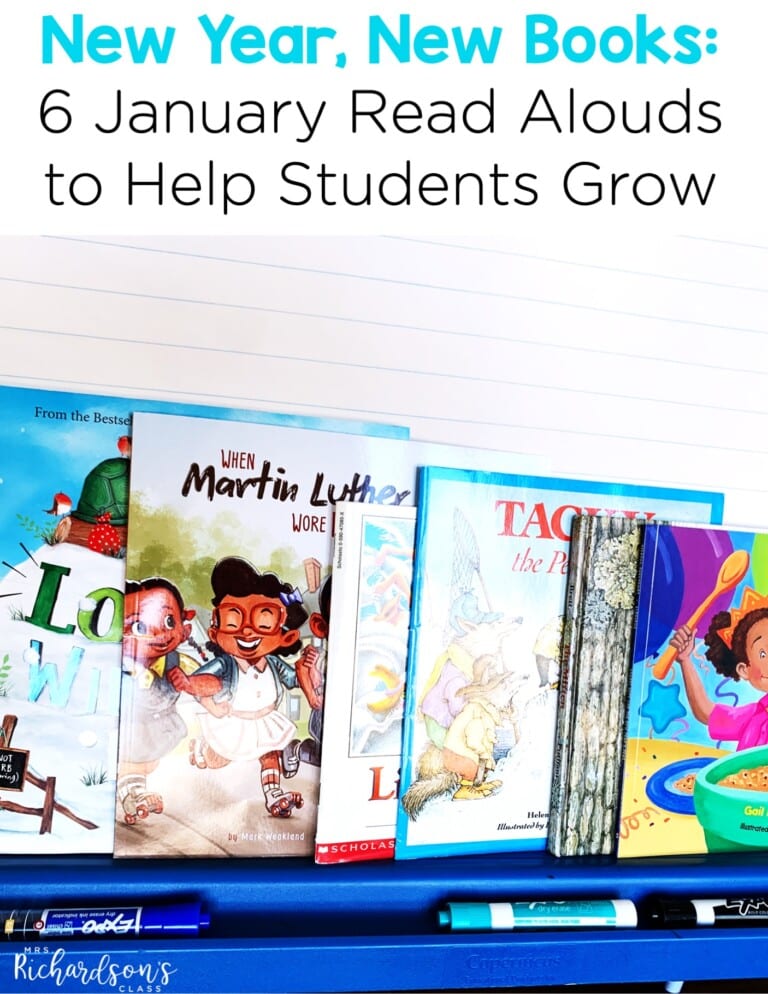

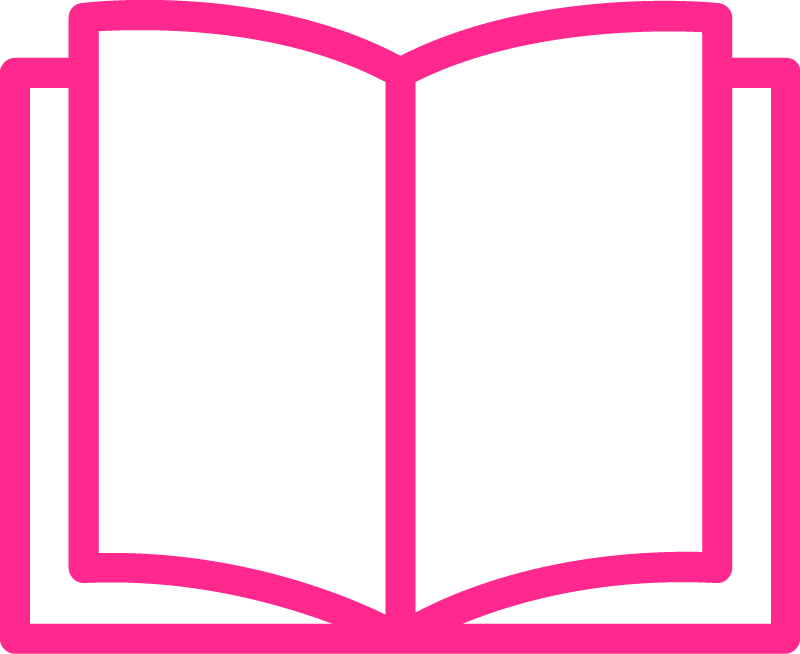
Teaching and structuring a guided reading lesson can seem overwhelming at first. I know that when I sat with my kids for the first time, though I had seen a great model, I was so worried about fitting it all in. I wasn’t sure if I was even teaching what I should. I felt like I had no clue
Eventually, I broke it down, found my focus for each leveled group with the resource cards. I got into a rhythm. My groups were rocking and rolling!
Let’s take a look at what this time looked like in our classroom and how I structured our time. Every classroom is different. There might be something else that works best for you and your students, but overall, these are areas that everyone is touching on.
Also, keep in mind that the purpose of guided reading is for the teacher to coach students during reading time.
When students come to my table, I want everything ready to go because I do not have a minute to spare. I generally have:
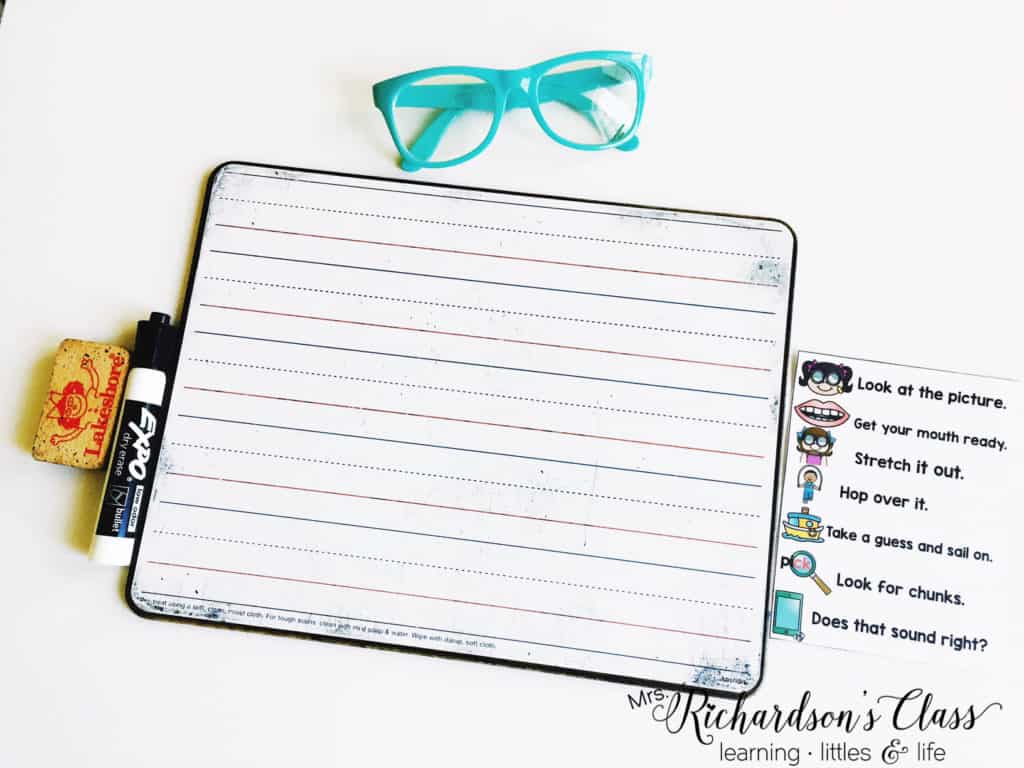
Besides the set of leveled readers for that group on hand, the other resources I like to keep handy and have set up for the students are:
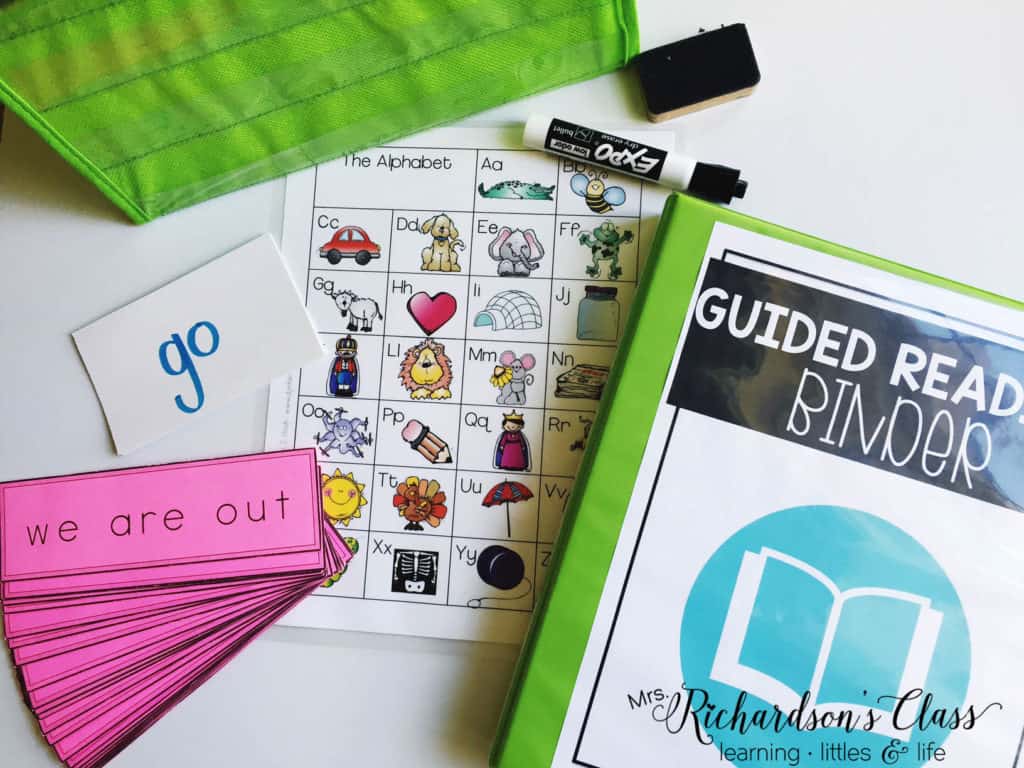

Here is a quick overview of our 20 minutes together.
Let me break it down a bit.
When students first come to my table, I have them “warm up their brains” by re-reading the book they have been taking home. If I choose, I could do a running record at this time on a student, but keep in mind that this is not a cold read, meaning it’s on a text that the student has seen, read and re-read at home several times. It’s not an accurate measure of their independent reading level.
We then place our books on the floor and do word work together. This varies based on each group’s reading level. For some, it’s simply us using the alphabet chart and reading through it together as we chant, “Apple, apple. /a/, /a/, /a/.”
For others, they may sort their alphabet letters in order and then we may do a short activity to make words.
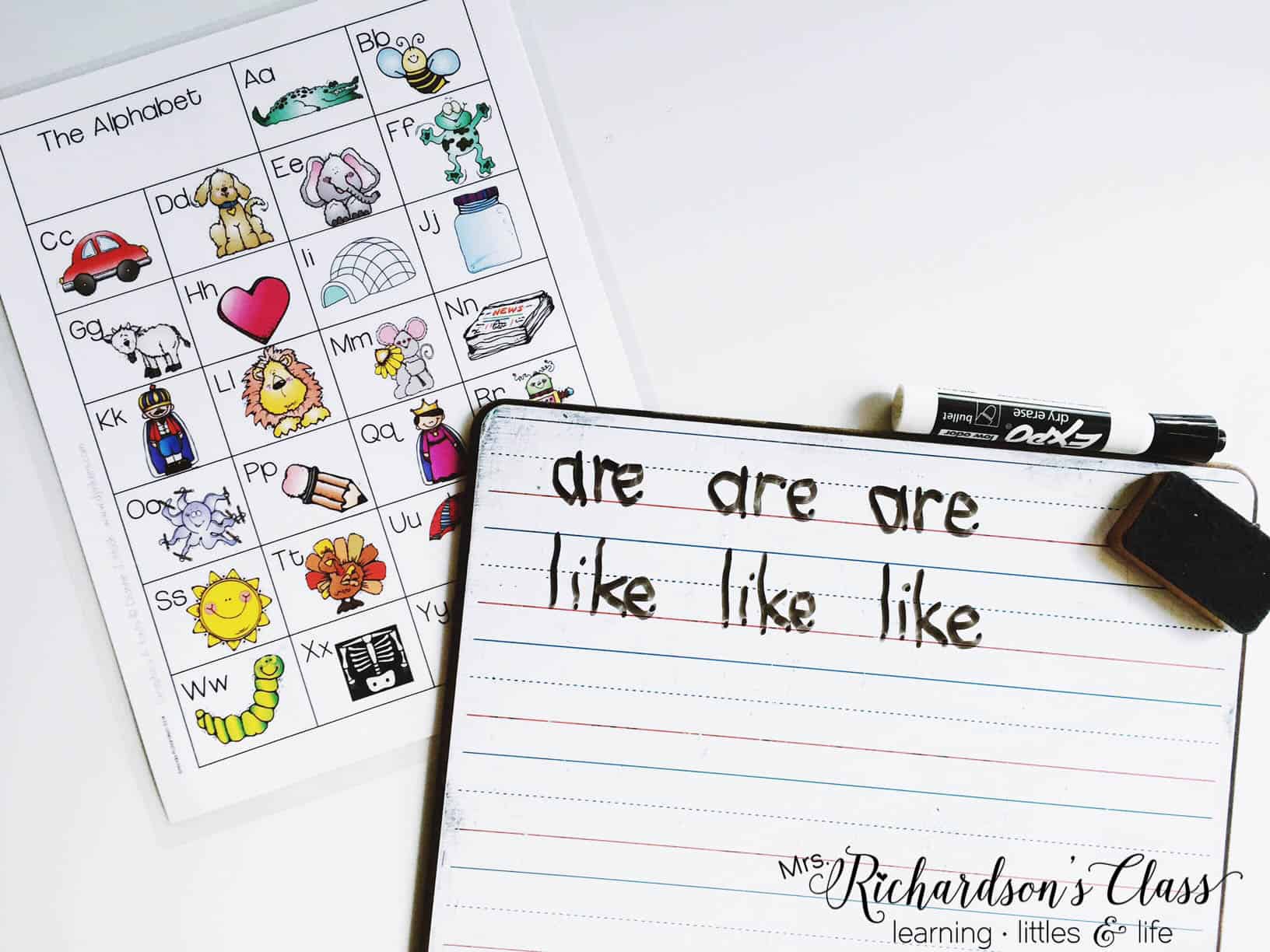
For all, I will review sight words that are found in the text we are going to read for that day. I will show them the sight word cards or they will find the sight word on the word wall, write it three times fast, and then we will read it three times fast.
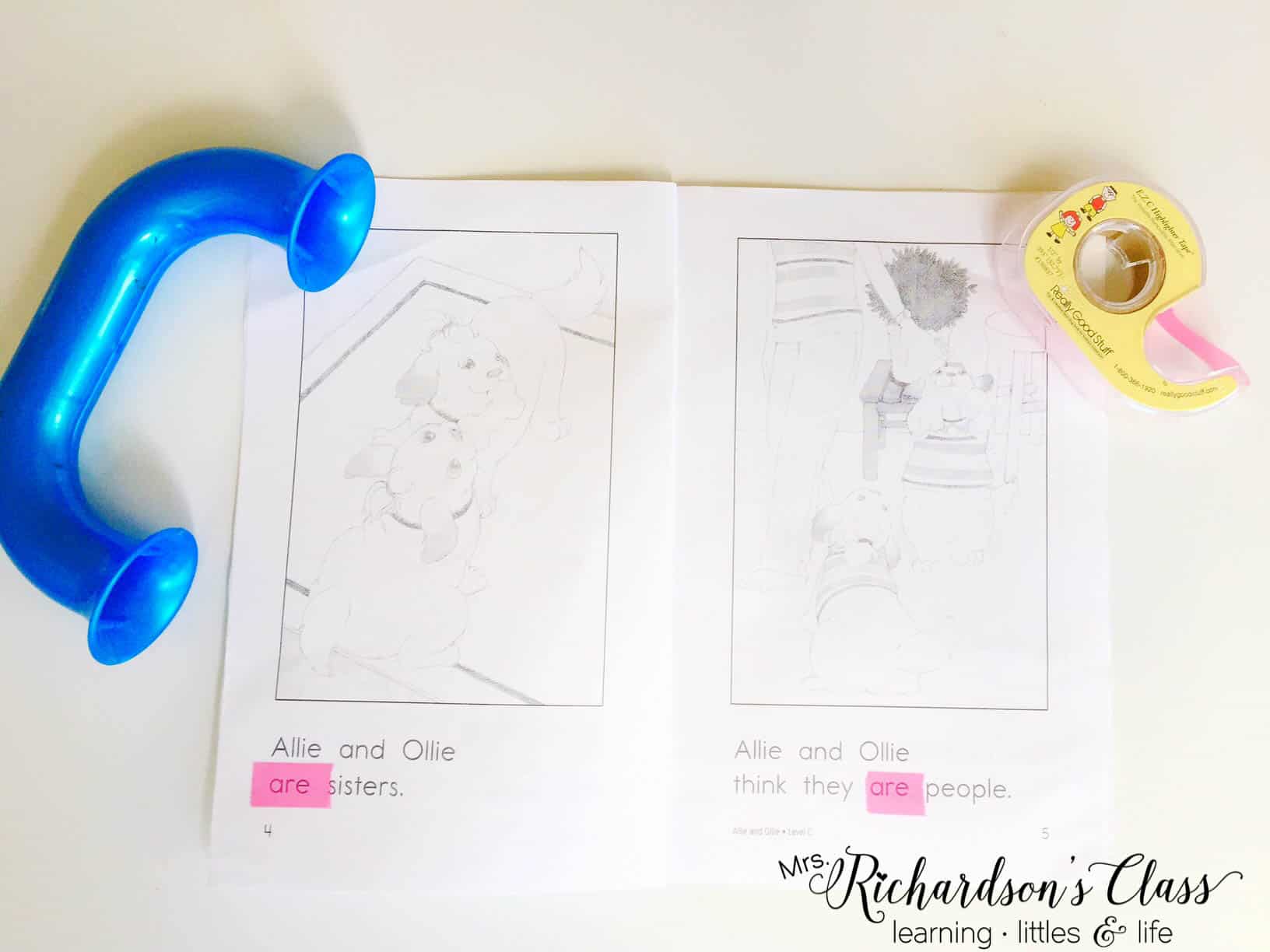
At this point, I will introduce the students to the book. For example, “Today we are going to read a silly book about two dogs who think they are people!” I tell them that the sight word ____ is in the book and we then go on a sight word hunt with highlighter tape looking for that word.
I would then prompt them to make a connection and help them predict what they may read about. “Have you ever seen a dog act like it was a person? What did it do?” I would allow the students to share.
Next, I would allow the students to take a picture walk through the book and talk about what they see the dogs doing. This is great for ELLs because it helps them practice the vocabulary that they will soon read. It also serves as a time for me to correct if needed.
Finally, I will go over and introduce anything that might catch them off guard. For example, if there is a picture of a dog, but the page says “puppy”, I might review that a baby dog is called a puppy. I don’t want to set them up to fail, but I also don’t want to give them every word in the book that they will see. 😉
I then set the purpose for reading by saying, “Now let’s read to find out how the two dogs are like people. When we are done, we are going to make a list of things they did.” Students need to have an authentic purpose for reading and know what it is.
I then set the students free to read the book aloud in a whisper voice independently. They read the book three times. We love to use whisper phones for this! If you don’t have a full set of six whisper phones, don’t worry. They can take turns using what you have – that’s what my students did.
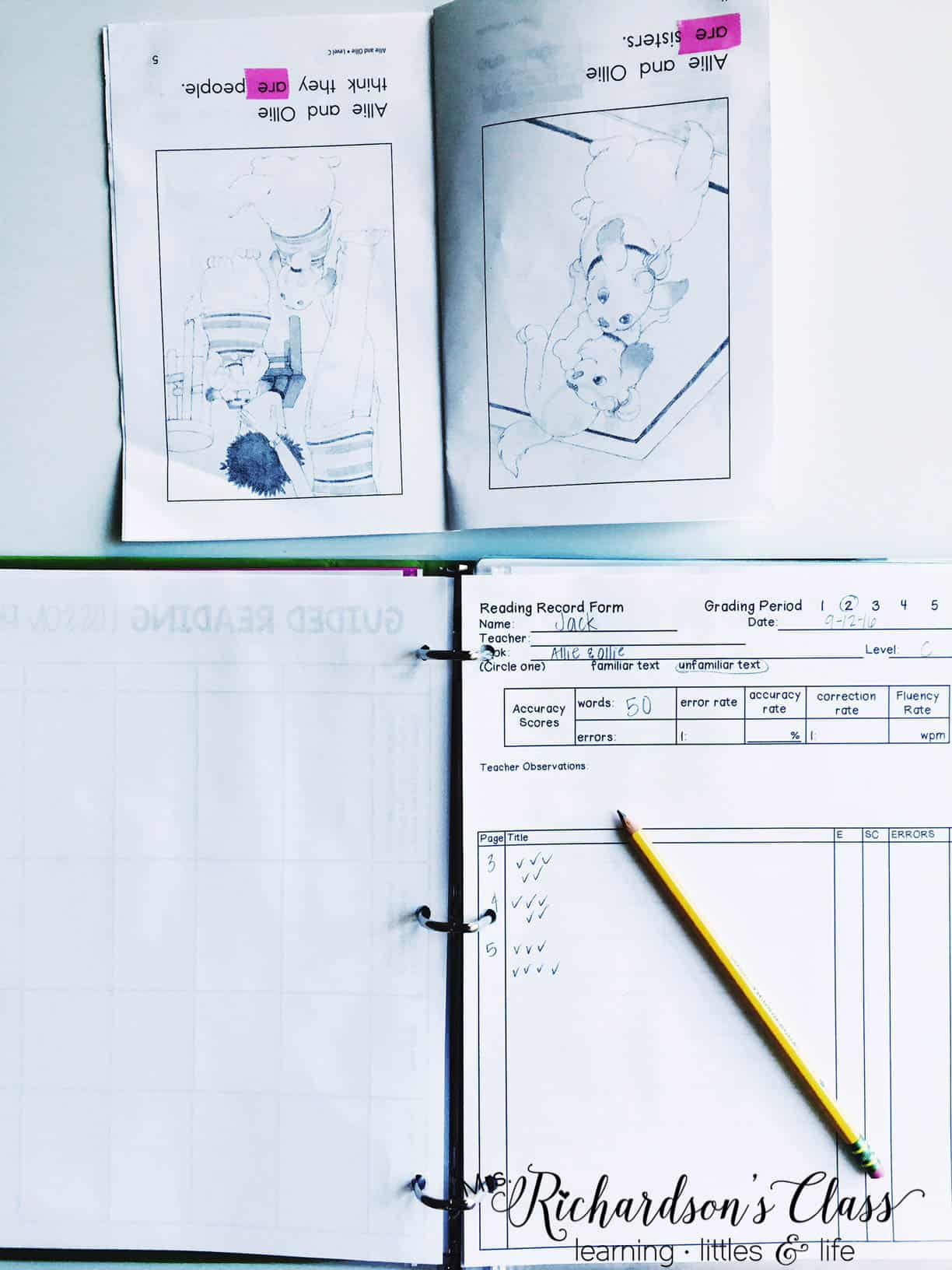
When the students are whisper reading, I listen to someone read and take a running record in my guided reading binder. I like to keep all of this organized in my binder. It’s easy for me to take a quick look and see who I haven’t listened to this week and who I have. After I take a running record, I usually listen to someone else read and simply take notes of things they are doing well and things they are not.
When everyone is done reading, we talk together about what happened in the book. Sometimes we do this by doing a 5 finger retell, retelling with a simple beginning, middle, end retell, or by talking about characters, setting, problem, and solution. This all just depends on their level. I like to use my Guided Reading Resource Cards to make sure I am targeting the right skills! Grab them FREE HERE.
Sometimes we will do quick writes. This is when I will have the students write one sentence to:
Not only do they love using the dry erase boards, but they love to write about what they just read. Since it’s simple and short, everyone gets to share their writing, and it’s always praised with specific feedback.
For example, “Joshua did a great job writing the sounds he heard.” “Kayla started her sentence with a capital letter.” “Niko did a fabulous job of making a vertical list.”
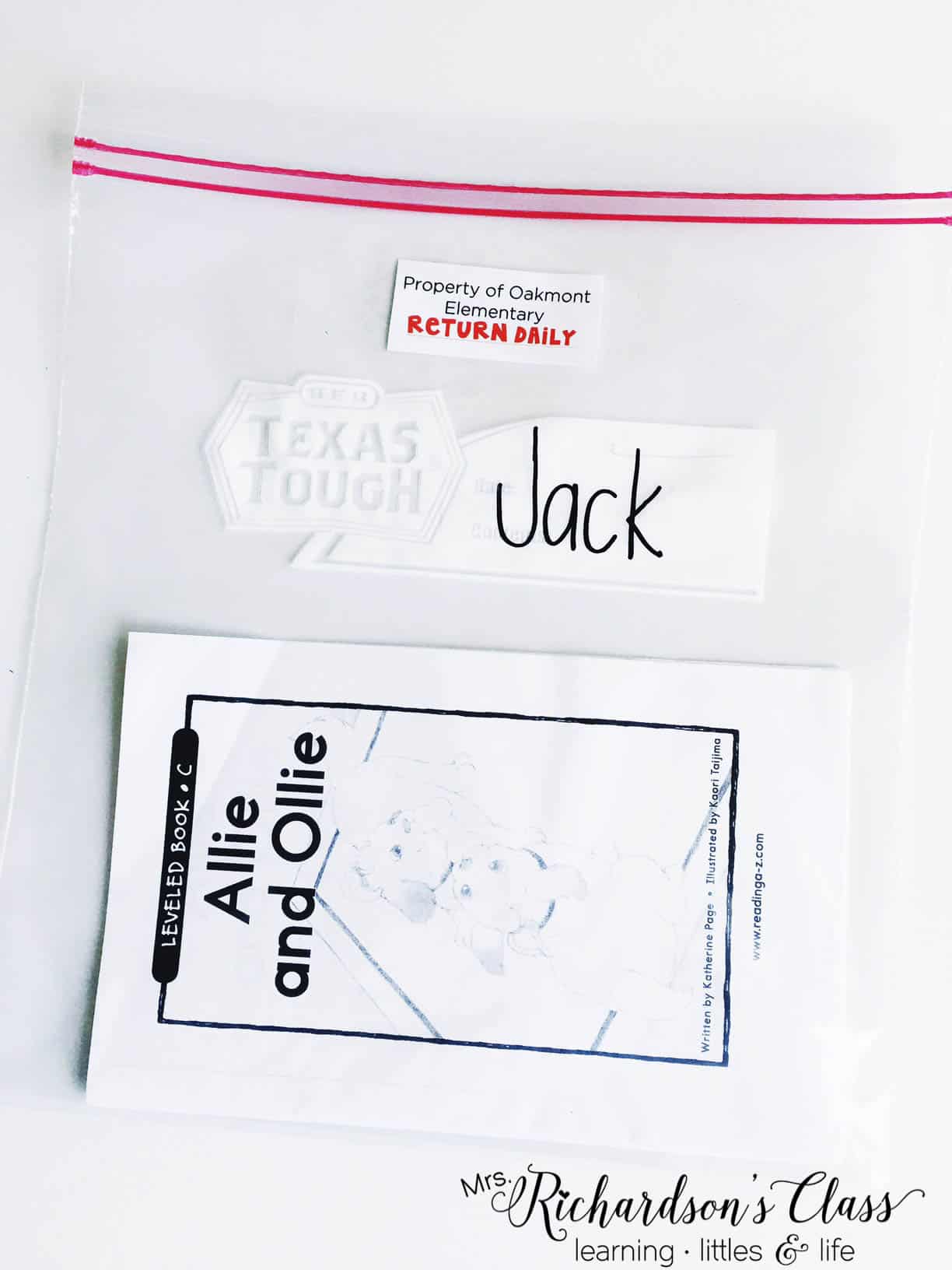
When we are done, each student takes home their new book in their book bag to read at home. I just ask that they read it three times at home. Not only are they taking home the text that I know they can read and be successful at, but if parents are not available to sit and listen to them read (though I hope they are!), students can STILL be successful because they have read with me. I am setting them up to succeed, not to fail.
After a few weeks of them seeing the table set and going through the routine this time flows well! Structuring a guided reading lesson and preparing beforehand just a tad bit helped so much.
It does take time and practice so don’t be discouraged! But nothing made my heart pitter-patter more than at the end of the year hearing a child say, “My favorite part of kindergarten was reading at Mrs. Richardson’s table.”
If you want to have guided reading made even easier, check out my leveled Guided Reading Kits for Kindergarten, First Grade, and Second Grade. Each kit has everything you’ll need to successfully implement a guided reading lesson including:
Grab yours today to help you learn how to successfully structure and implement a powerful guided reading lesson!
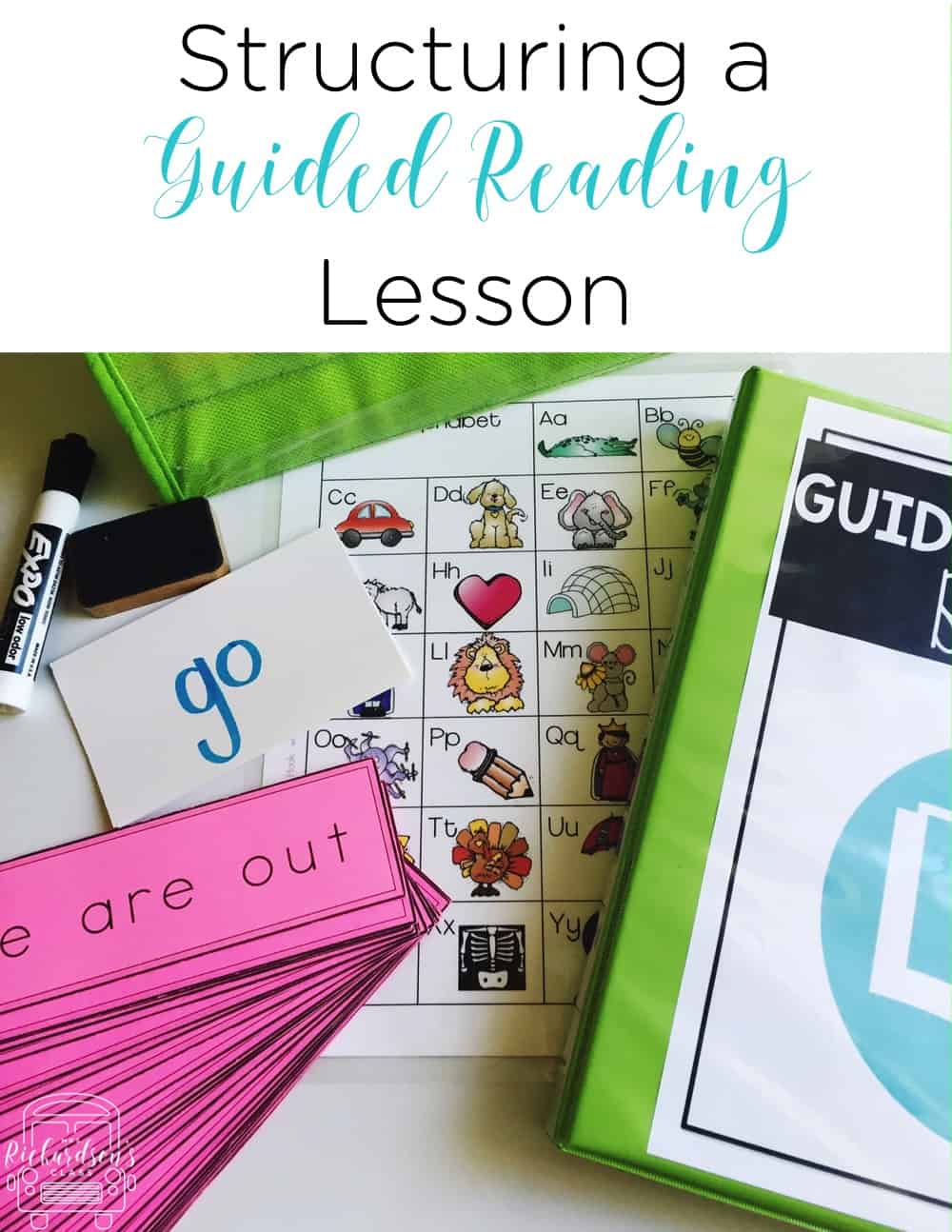
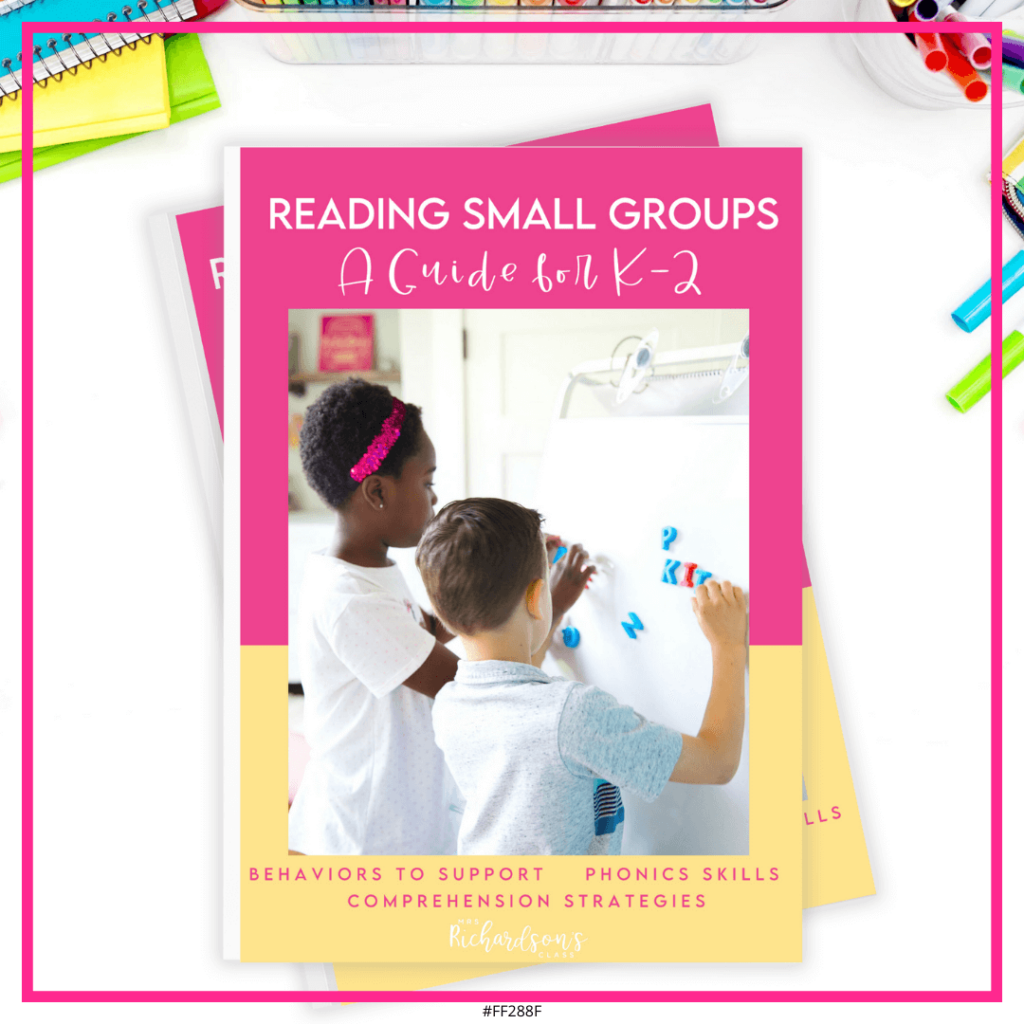
Want to use the latest research to boost your readers during small groups? This FREE guide is packed with engaging ideas to help them grow!
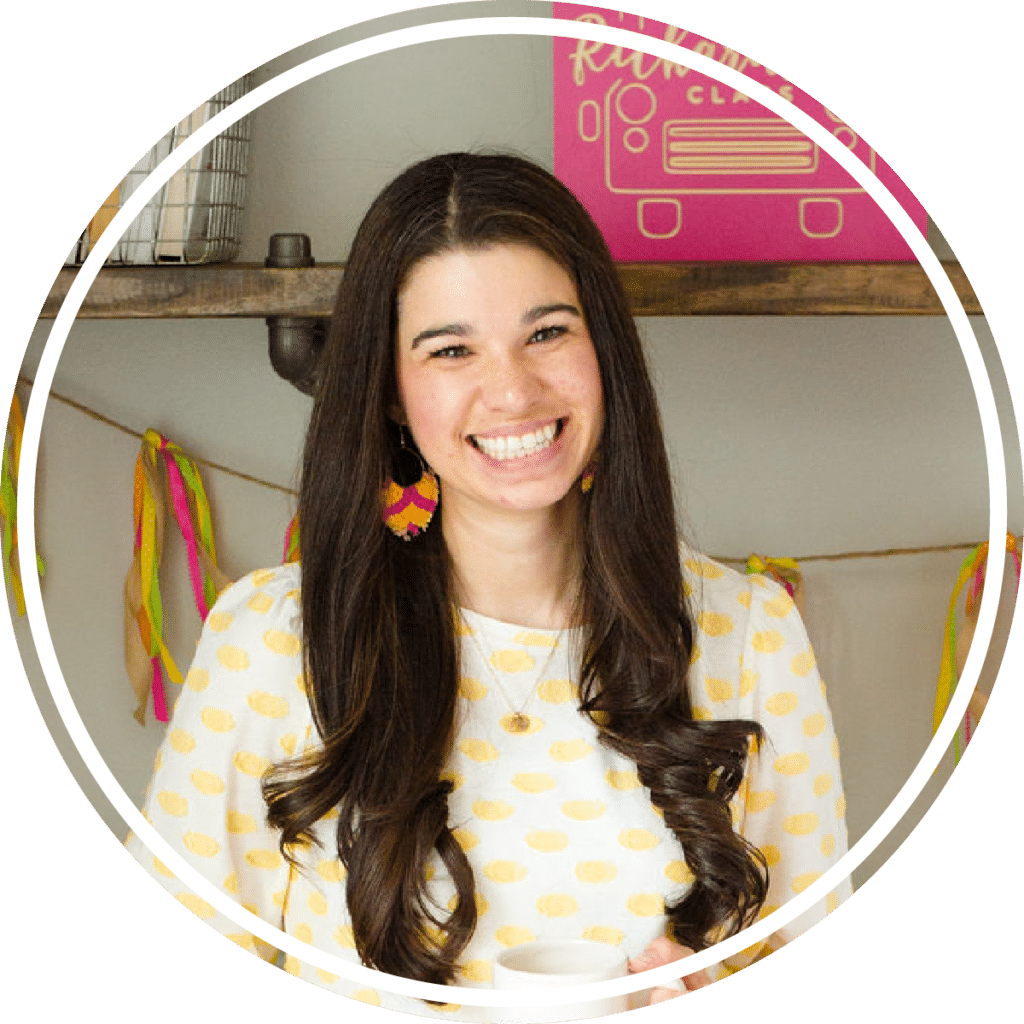
I’m a K-1 teacher who is passionate about making lessons your students love and that are easy to implement for teachers. Helping teachers like you navigate their way through their literacy block brings me great joy. I am a lifelong learner who loves staying on top of current literacy learning and practices. Here, you’ll find the tools you need to move your K-2 students forward!
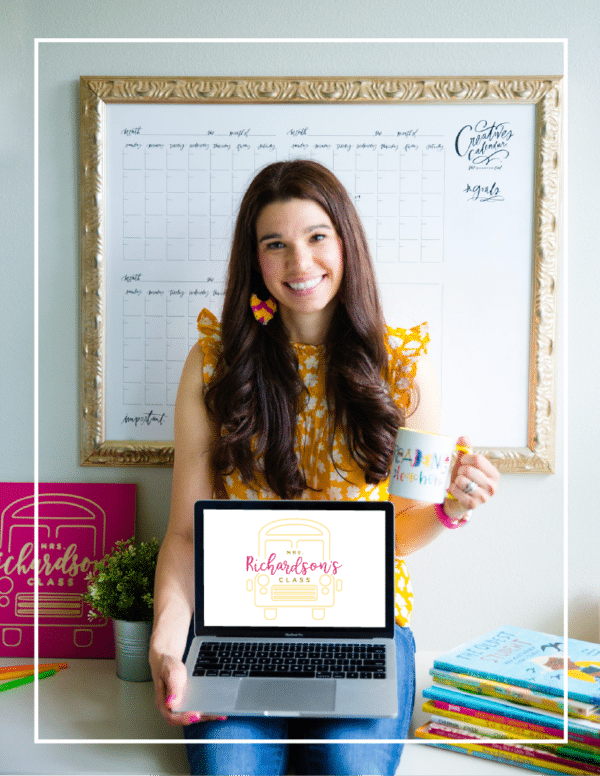
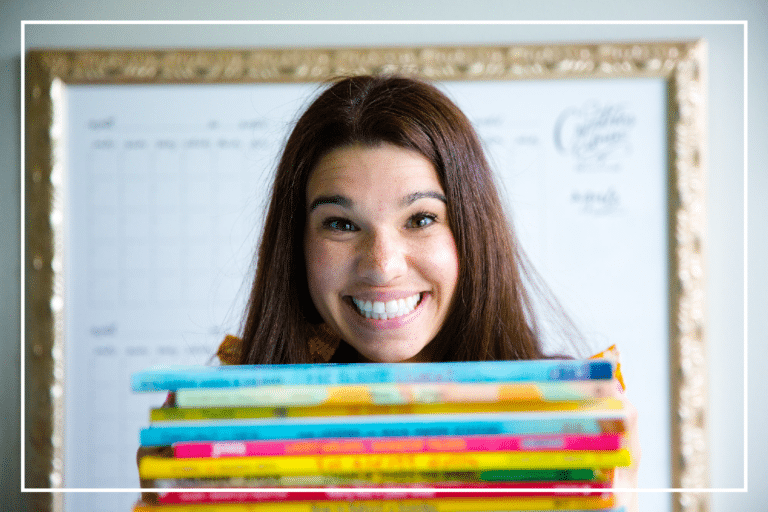
| Cookie | Duration | Description |
|---|---|---|
| cookielawinfo-checkbox-analytics | 11 months | This cookie is set by GDPR Cookie Consent plugin. The cookie is used to store the user consent for the cookies in the category "Analytics". |
| cookielawinfo-checkbox-functional | 11 months | The cookie is set by GDPR cookie consent to record the user consent for the cookies in the category "Functional". |
| cookielawinfo-checkbox-necessary | 11 months | This cookie is set by GDPR Cookie Consent plugin. The cookies is used to store the user consent for the cookies in the category "Necessary". |
| cookielawinfo-checkbox-others | 11 months | This cookie is set by GDPR Cookie Consent plugin. The cookie is used to store the user consent for the cookies in the category "Other. |
| cookielawinfo-checkbox-performance | 11 months | This cookie is set by GDPR Cookie Consent plugin. The cookie is used to store the user consent for the cookies in the category "Performance". |
| viewed_cookie_policy | 11 months | The cookie is set by the GDPR Cookie Consent plugin and is used to store whether or not user has consented to the use of cookies. It does not store any personal data. |
54 Responses
Love this site
Love this. I do a lot of the things you mentioned already but learned new ways to utilize and improve upon those. Thank you 🙂
I would like to get a print out of the 20 minute guided reading poster to post at my reading table. It can be a quick guide for substitutes as well as myself.
Thanks
Kim Buettner
Hi Kim! That’s a great suggestion! I’ll add that to my to-do list! 🙂
I teach high school ELLs, but your post is certainly relevant and helpful. Guided reading is enormously helpful as upper school ELLs learn academic language and higher level literature. I appreciate the clarity of your explanations. I’m not as purposeful in my reading times and this has encouraged me! Thanks!
When do you start your guideded reading groups?
Hi Kami! I usually start them week 6 of school. 🙂
What is the first 76 weeks of school like before you start groups?
Hi Alicia! I just wanted to make sure you got my email I sent you about this. 😉
Hi Amanda,
Thanks for sharing your knowledge.
How can I get the fluency strips.
Thanks!
Hi Dorrie! I do not have a copy of them. My teammate had found them FREE online and passed them on to me. Try searching fluency phrases and see what you can find! 🙂
Where can I find your Reading at Home with your child parent memo? Thank you.
You can find it here! https://www.mrsrichardsonsclass.com/fostering-love-reading/
Thank you so much!
Thank you so much for all the help with guided reading. Thanks, too, for the free alphabet page – planning to use this with my new 2nd graders (who are “barely” readers.) Question: What is the picture for V? Volleyball? Vine? Can’t tell for sure, so wanted to be confident in what I say! Thanks.
Yes! It’s a volleyball! 🙂
Loved reading how you ran guided reading. Thank you for sharing. Can you tell me how many days you read the same book? How often do you introduce a new one?
Oh how wonderful!! You are welcome! For my kids reading in levels i/j and below, we did one book per group meeting time. 🙂
Love all the guided reading tips and freebies – thank you. Just a quick question for you regarding levelled readers as I was thinking of taking a subscription with reading a-z to print books for my classroom as I do not have access to a big selection of levelled readers. I see you have used some of the reading a-z readers printed in black and white and I was wondering do you find the black and white books engaging for your students as this is the way I was thinking of going. Thanks a lot.
Hi Susan! Great question! I honestly NEVER had a kid say anything about getting a black and white book. I always copied them in black and white, too! 🙂
Thanks Amanda – I’ll try it so. Would make it so accessible if black and white used. Thanks again. Love the information.
Hi. I absolutely love everything! I appreciate all the information you have shared. Where can I find the activity…apple, apple, apple /a/ /a/ /a/? I saw this somewhere before, but I can’t seem to find it?
Hi Michelle! I think you are looking for this! Let me know if not! https://www.mrsrichardsonsclass.com/how-tracing-letters-helps-letter-identification/ OR you could be looking for this post with the alphabet chart! https://www.mrsrichardsonsclass.com/guided-reading-with-non-readers/
Amanda, I’ve gathered so much great information from your blog about guided reading. I do have a quick question and I’m not sure if you’ve already stated it or not so forgive me if you have. How do you rotate groups? Do you go through a couple groups a day? Do you see all of your groups? I’m curious for a time table of what this all looks like.
Thank you!
Annie
Hi Annie! I’m so glad you have found things helpful! I always tried to do 3 groups a day and I usually had 5-6 groups. This blog post has an example of my schedule. https://www.mrsrichardsonsclass.com/scheduling-creating-guided-reading-groups/
Thank you so much. Love the information
Did you ever make a copy of your 20 minute plan for purchase? I am hoping to find specifically that, but I do not need a whole bundle (ie. if it’s only available in your Guided Reading Binder bundle).
Hi Sarah! I did not. You can see everything in the graphic on the blog post, though! Also, it is not in the binder so while I LOVE the binder and it is such a helpful tool for many, the 20 minute lesson breakdown is not in there. 🙂